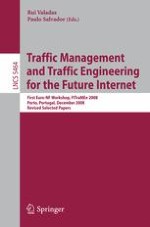2009 | Book
Traffic Management and Traffic Engineering for the Future Internet
First Euro-NF Workshop, FITraMEn 2008, Porto, Portugal, December 11-12, Revised Selected Papers
Editors: Rui Valadas, Paulo Salvador
Publisher: Springer Berlin Heidelberg
Book Series : Lecture Notes in Computer Science
